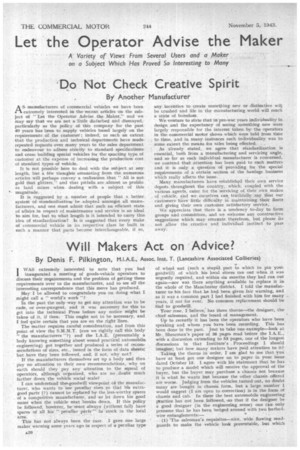Will Makers Act on Advice?
Page 22

Page 25

If you've noticed an error in this article please click here to report it so we can fix it.
By Denis F. Pilkington, M.I.A.E., Assoc. Inst. T. (Lancashire Associated Collieries)
I WAS extremely interested to note that you had ./ inaugurated a meeting of goods-vehicle operators to discuss their requirements and the problem of getting these requirements over to the manufacturers, and to see all the interesting correspondence that this move has produced.
May I be allowed to congratulate you on doing what I might call a "world's work "?
In the past the only way to get any attention was to be rude, or over-pungent, and it was necessary for this to get into the technical Press before any notice might be taken of it, if then. This ought not to be necessary, and I feel quite certain that you are on the right lines.
The matter requires careful consideration, and from this point of view the S.M.M.T. (ean we rightly call this body " the manufacturers "?) and the I.A.E. (presumably a body knowing something about sound practical automobile, engineering) got together and produced a series of recommendations of sizes, etc., issued in the form of data sheets; but have they been followed, and, if not, why not?
If the manufacturers themselves set up a body and then fiay no attention to their own recommendations, why on earth should. they pay any attention to the squeal of operators, although' organized, who are no .doubt much farther down the vehicle social scale?
I can understand thee goodwill viewpoint .of the manufacturer, who wants to use peculiar sizes so that his extragood parts. (?) cannot be replaced by the less-worthy spares of a competitive manufacturer, and so let down his good name when the vehicle next breaks down. If this policy he followed, however, he must always (without fail) have spares of all his " peautiar parrs " in stock in the local area.
This has not always been the case. I gave one large maker warning some years ago in respect of a peculiar type
of wheel nut (such a stupia part to which to pin yout goodwill) of which his local stores ran out when it was urgently required, and within six months they had run out again—nor was there anything available to replace it in the whole of the Manchester district. I told the manufacturer to his_ face that he ha4 been given fair warning, and as it was a common part I had finished with him for many years, if not for ever. No common replacement should be tied to goodwill.
Your rose, I believe; has three thorns—the designer, the chief salesman, and the board of management.
Up to recently it has been the operators who have been speaking and whom you have been recording. This has been done 'in the past. Just to take one example—look at Mr.. Shearman's paper of 36 pages read before the I.A.E., with a. discussion extending to 53 pages, one of the longest discussions in that Institute's Proceedings I should imagine; but how many makers have paid attention to it?
Taking the thorns in order, I am glad to see that you have at least got one designer on to paper in your issue dated October 15. I agree with his statement that he has to produce a model which will receive the approval of the buyer, but the buyer may purchase a chassis not because it is what he wauts but because the other chassis offered are worse. Judging from the vehicles turned out, no doubt many are bought in chassis form, but a large number I would suggest (I am open to correction) is in the form ot chassis and cab. In these the best automobile engineering' Isaac:ace has not been followed, .so that if the designer ty; a good designer (in the engineering sense) one can only presume that he has been hedged around with two barbedwire entanglements:—
(1) 'The salesman's requisites—nice, wide flowing mudguards to make the vehicle look presentable. but which hinder considerably the ease of getting to the engine, etc. (2) The board's requirements—cheapness, some accessories bought in the mass and cheaper than they should be, under-tyring (cheapness again), and masszproduction methods in the works. The present hidden radiator is a case in point (cheap to manufacture, highly efficient when clean, too high for many of us, and far too expensive when ' any repair is required—in many cafes its design, specially, leadiirg to a repair many years before it should be necessary, as with a less-efficient type).
Can you get a chief salesman to say what he thinks, although, apart from personal opinions, the artiele by Mr. Elston (who seems to have been on the sales, side once) in the same issue would seem to concrete the opinion that with some sales ,talk you must take more salt than with most other " facts." But certain chief salesmen might be
able to give some criticism, _constructive or otherwise, especially if they be responsible for restricting the designer. Lastly, could you get, say, the managing directors of a few of the bigger manufacturing concerns to state what they think of your idea, or, rather, what they would he prepared to listen to, or allow their designers to listen to. if it were likely to upset their line production, terribly . expensive automatics and presses? [Several prominent men amongst the makers have given their views since this contribution was written.—En.]
Time, however', roust not be lost, as most manufacturing concerns will, no doubt, even now have some blue prints (if not all) ready for the word " go," although I do know of one of them the board of which, only two months ago, was till hesitating over thecorrect chassis sizes for production, and this after questioning most of their past users.




















































